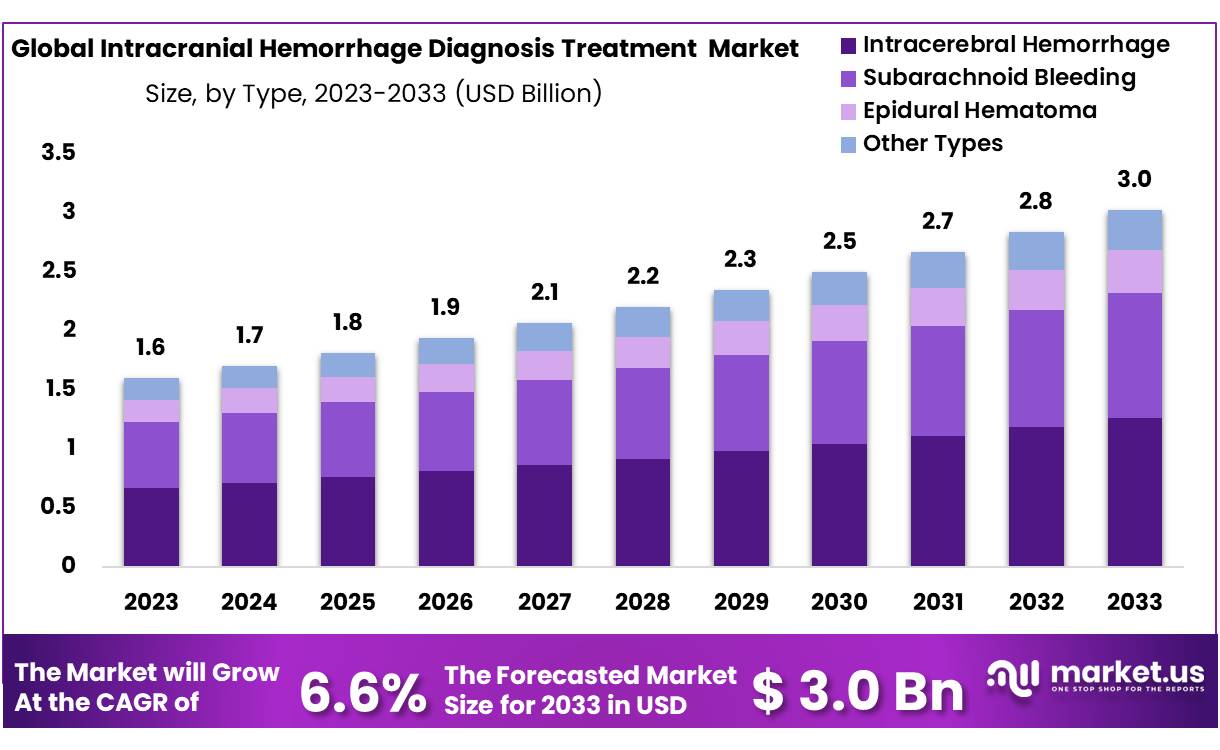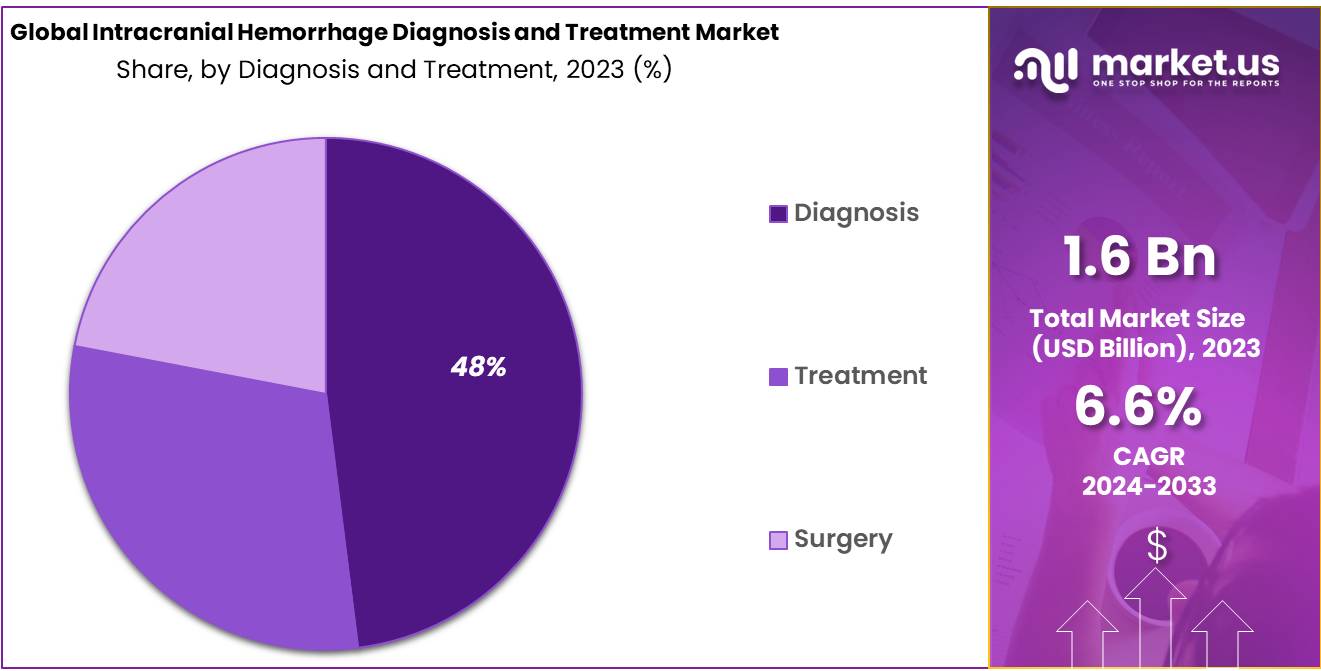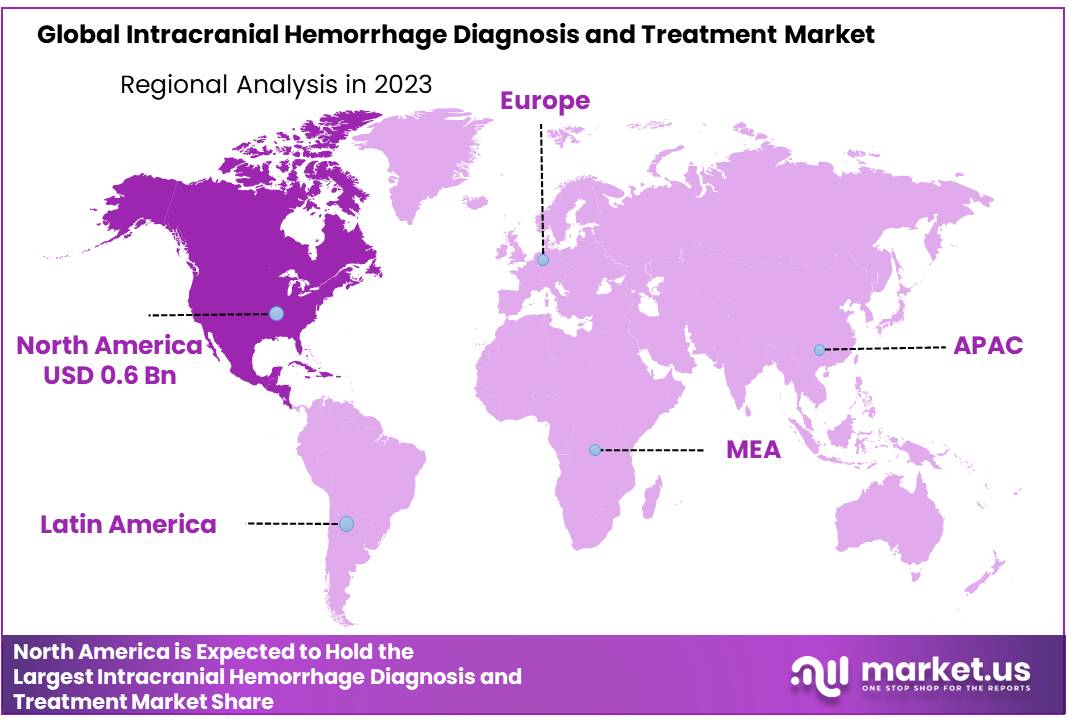Global Intracranial Hemorrhage Diagnosis & Treatment By Type (Intracerebral Hemorrhage, Subarachnoid Bleeding, Epidural Hematoma, Other Types) By Diagnosis & Treatment (Diagnosis, CT, MRI, Others) By Treatment (Anti-Hypertensive Drugs, Coagulants, Others) By Surgery( Decompression Surgery, Craniotomy with Open Surgery, Endoscopic Evacuation, Stereotactic Aspiration, Others) By Region and Companies - Industry Segment Outlook, Market Assessment, Competition Scenario, Trends and Forecast 2024-2033
- Published date: Feb 2024
- Report ID: 77732
- Number of Pages: 356
- Format:
- keyboard_arrow_up
Quick Navigation
Market Overview
The Global Intracranial Hemorrhage Diagnosis & Treatment Market size is expected to be worth around USD 3.0 Billion by 2033 from USD 1.6 Billion in 2023, growing at a CAGR of 6.6% during the forecast period from 2024 to 2033.
Intracranial hemorrhage is an acute medical emergency characterized by an accumulation of blood within the skull and consequently increasing intracranial pressure – potentially harming brain tissues in the process.
Bleeding in or around the brain due to a burst artery is known as a brain hemorrhage. It’s a certain type of stroke. A brain hemorrhage is often classified based on where it occurs in the brain. An intracranial hemorrhage is a type of bleeding that occurs anywhere inside the skull. When a blood artery within the skull ruptures or leaks, it causes intracranial hemorrhage, also known as intracranial bleed. It can result from physical trauma or non-traumatic causes such as a ruptured aneurysm. Anticoagulant therapy, as well as blood coagulation abnormalities, can increase the risk of an intracranial hemorrhage. Hypertension is the cause of more than half of all intracranial hemorrhages.
Subtypes of Intracranial hemorrhage are intracerebral hemorrhage, subarachnoid bleeds, epidural bleeds, and subdural bleeds. An intracerebral hemorrhage is a type of bleeding that occurs within the brain. A subarachnoid hemorrhage is a type of bleeding that occurs between the brain’s covering and the brain tissue itself. A subdural or epidural hematoma occurs when a blood clot forms between the skull and the brain, depending on whether it is below or above the brain’s protective covering (dura). A traumatic brain injury or a fall is the most common cause of subdural and epidural hematomas.
Intracranial bleeding is a serious medical emergency because the accumulation of blood within the skull can cause an increase in intracranial pressure, potentially crushing fragile brain tissue or limiting blood supply. Severe increases in Intracranial Pressure (ICP) can cause brain herniation, in which parts of the brain are squeezed past structures in the skull.

Key Takeaways
- Market Size: Intracranial Hemorrhage Diagnosis & Treatment Market size is expected to be worth around USD 3.0 Billion by 2033 from USD 1.6 Billion in 2023
- Market Growth: The market growing at a CAGR of 6.6% during the forecast period from 2024 to 2033.
- Type Analysis: Intracranial hemorrhage is an ever-evolving field, with intracerebral hemorrhage taking an impressive 47% market share.
- Diagnosis & Treatment Analysis: Diagnosis of intracranial hemorrhage management is of central importance, accounting for 43% market share.
- Regional Analysis: North America achieved unprecedented revenue generation in 2023, holding approximately 38% market share and held USD 0.6 billion in market revenue.
Type Analysis
By type analysis,Intracranial hemorrhage is an ever-evolving field, with intracerebral hemorrhage taking an impressive 47% market share. This type of bleeding within brain tissue itself has attracted widespread recognition within healthcare facilities worldwide.
Subarachnoid hemorrhage, another critical aspect of intracranial hemorrhage, has seen great strides forward in recent years. Although its market share may not compare to intracerebral hemorrhage’s, its significance should not be underrated – subarachnoid bleeding occurs between the brain and its surrounding membrane and advances in diagnosis and treatment are creating hope among industry experts.
Epidural hematoma, although comprising only a smaller share of the market, remains an urgent concern due to its potential for rapid deterioration. Progress is being made towards addressing diagnostic challenges and optimizing treatment strategies for epidural hematoma.
Diagnosis & Treatment Analysis
By diagnosis & treatment analysis, Diagnosis of intracranial hemorrhage management is of central importance, accounting for 43% market share. Imaging technologies, specifically Computed Tomography (CT) and Magnetic Resonance Imaging (MRI), play an instrumental role in providing precise evaluation and prompt treatment of this acute medical condition.
CT scans have long been recognized as an efficient means to quickly and precisely diagnose intracranial hemorrhage. Their capacity to quickly capture detailed images of brain structures quickly during emergency settings makes CT scans invaluable tools in providing timely intervention for hemorrhagic stroke patients and in improving patient outcomes. CT scanning’s ability to detect blood in cranial cavities plays a pivotal role in patient care outcomes.
MRI provides distinct advantages when diagnosing intracranial hemorrhages. With its exceptional soft tissue contrast and ability to distinguish acute from chronic hemorrhages, MRI provides essential information needed for effective treatment decisions.

Market Segments
Type
- Intracerebral Hemorrhage
- Subarachnoid Bleeding
- Epidural Hematoma
- Other Types
Diagnosis & Treatment
- Diagnosis
- CT
- MRI
- Others
Treatment
- Anti-Hypertensive Drugs
- Coagulants
- Others
Surgery
- Decompression Surgery
- Craniotomy with Open Surgery
- Endoscopic Evacuation
- Stereotactic Aspiration
- Others
Drivers
Aging Population and Rising Stroke Incidence
One of the primary factors driving growth in intracranial hemorrhage diagnosis and treatment market is an increasing global aging population. With individuals getting older comes increased risks for stroke and intracranial hemorrhage; due to an aging demographic in many regions growing older together with increasing demand for accurate and efficient diagnoses/treatement options; this demographic shift drives market expansion as healthcare providers address specific needs in vulnerable groups such as this one.
Imaging Technologies Advance
Technological advances, particularly those related to imaging technology, are driving market development forward. High-resolution computed Tomography (CT) scans and Magnetic Resonance Imaging (MRI) machines have become more accessible and sophisticated for healthcare providers to accurately detect intracranial hemorrhages with more precision leading to improved treatment outcomes. Furthermore, artificial intelligence and machine learning image analysis software is streamlining diagnostic procedures while shortening time required for assessments thereby further improving patient care outcomes.
Trends
Telemedicine and Virtual Consultations
Telemedicine and remote consultations have emerged as an emerging trend in intracranial hemorrhage diagnosis and treatment market, particularly where there is limited access to specialists for neurology diagnoses or interventions. Telemedicine allows healthcare providers to quickly assess patients, interpret images remotely and collaborate with specialists reducing delays for treatment initiation while improving patient outcomes – particularly important when stroke and hemorrhage occur simultaneously. It’s expected this trend will expand even more significantly among regions lacking neurology specialists.
Personalized Medicine and Targeted Therapies
Personalized medicine is quickly establishing itself in the intracranial hemorrhage market. Researchers are studying genetic and molecular factors which influence an individual’s susceptibility to intracranial hemorrhage; using this knowledge allows targeted therapies and treatments tailored specifically for each patient, potentially improving efficacy while simultaneously decreasing side effects. As personalized medicine emerges as a solution to intracranial hemorrhage treatment over time.
Restraints
Rising Costs for Advanced Imaging
Owing to its cost-intensive nature, advanced imaging technologies like CT and MRI machines may present serious barriers for healthcare facilities operating on limited budgets; such barriers may prevent timely diagnoses and treatments being available that improve patient care outcomes.
Limited Awareness and Education
One major limitation of the intracranial hemorrhage market is lack of awareness and education surrounding its symptoms and risk, thus leaving most members of society unaware about early intervention opportunities and possible risks associated with intracranial hemorrhage. Raising public awareness as well as informing healthcare providers on current diagnostic and treatment guidelines are integral parts of improving patient outcomes after experiencing intracranial hemorrhage.
Opportunities
Healthcare Infrastructure Expansion
Intracranial hemorrhage diagnosis and therapy is currently a highly profitable commercial opportunity because of the vast number of hypertension patients, as well as the potential of increasing research efforts concerning potential therapeutic molecules. Furthermore, technical advancements such as point-of-care drug delivery systems, together with a growing focus on maintaining a superior quality of life, are elements that are contributing to this market’s revenue growth trajectory. Another factor contributing to this market’s further expansion is the increasing incidence of traumatic injury patients.
Research and Development of Novel Therapies
Hunting down novel therapies and interventions for intracranial hemorrhage is an exciting prospect, with pharmaceutical companies and research institutions exploring innovative treatments like neuroprotective agents and minimally invasive surgical techniques as possible solutions to intracranial bleeding. Investments in R&D could produce breakthrough solutions that significantly improve patient outcomes while driving market expansion.
Regional Analysis
North America achieved unprecedented revenue generation in 2023, holding approximately 38% market share and held USD 0.6 billion in market revenue. Beyond substantial research funding, the region also faces high rates of various medical conditions including aneurysms. Notably, major manufacturers in North America are poised to bring forth innovative new product offerings, collaborate to enhance cash flow management practices, and outsource some production processes.
Integrating clinical data to gain insight into prognosis for cerebral bleeding and explore therapeutic options is another exciting development, which should catalyze research activities across the region. One such initiative by The Radiological Society of North America (RSNA), entitled 2019 Brain CT Hemorrhage Challenge aimed at creating machine-learning dataset using appropriate methodologies is noteworthy in this respect.
Meanwhile, Asia-Pacific region stands to experience robust expansion of cerebral hemorrhage diagnosis and treatment market. This increase can be explained by increased investments in research and development, especially to build healthcare infrastructure within developing nations like China and India. Additionally, this region faces an increase in traumatic brain injuries caused by accidents and trauma which contribute to market expansion. Rising demand for cutting-edge medications, government healthcare initiatives and increased public understanding about brain hemorrhage risks and available treatments all play a part in driving growth in Asia-Pacific markets.

Key Regions and Countries
North America
- The US
- Canada
- Mexico
Western Europe
- Germany
- France
- The UK
- Spain
- Italy
- Portugal
- Ireland
- Austria
- Switzerland
- Benelux
- Nordic
- Rest of Western Europe
Eastern Europe
- Russia
- Poland
- The Czech Republic
- Greece
- Rest of Eastern Europe
APAC
- China
- Japan
- South Korea
- India
- Australia & New Zealand
- Indonesia
- Malaysia
- Philippines
- Singapore
- Thailand
- Vietnam
- Rest of APAC
Latin America
- Brazil
- Colombia
- Chile
- Argentina
- Costa Rica
- Rest of Latin America
Middle East & Africa
- Algeria
- Egypt
- Israel
- Kuwait
- Nigeria
- Saudi Arabia
- South Africa
- Turkey
- United Arab Emirates
- Rest of MEA
Market Player Analysis
The competitive landscape of the intracranial hemorrhage diagnosis and treatment market furnishes comprehensive information on each competitor. This information encompasses various aspects, including company overview, financial performance, revenue generation, market potential, investment in research and development, recent market endeavors, global reach, production facilities, capacity, strengths and weaknesses, product launches, product range, and dominant applications. It’s important to note that the data points mentioned above are exclusively relevant to the companies’ activities within the intracranial hemorrhage diagnosis and treatment market.
Market Key Players
- InfraScan, Inc
- GE Healthcare
- Medtronic plc
- Siemens AG
- Stryker Corporation
- Bristol-Myers Squibb Company
- Novartis AG
- Canon, Inc.
- Koninklijke Philips N.V
- Integra LifeSciences Corporation
Recent Developments
- InfraScan, Inc.: Partnered with BrainScope in September 2023 to integrate its ICH detection software with BrainScope’s concussion assessment platform.
- GE Healthcare: Launched the Discovery Revolution CT scanner with STROKE.AI software in October 2022, which uses artificial intelligence to analyze CT scans and identify ICH faster and more accurately.
- Siemens Healthineers: Introduced the AI-powered myExam Companion for Neuro CT in June 2022, which assists radiologists in interpreting CT scans for ICH and other neurological conditions.
- Canon Medical Systems: Partnered with Brainlab in October 2022 to develop integrated solutions for image-guided ICH treatment procedures.
- Koninklijke Philips N.V.: Partnered with Medtronic in October 2022 to develop minimally invasive interventional solutions for ICH treatment.
Report Scope
Report Features Description Market Value (2023) USD 1.6 Billion Forecast Revenue (2033) USD 3.0 Billion CAGR (2024-2033) 6.6% Base Year for Estimation 2023 Historic Period 2018-2022 Forecast Period 2024-2033 Report Coverage Revenue Forecast, Market Dynamics, Competitive Landscape, Recent Developments Segments Covered By Type-(Intracerebral Hemorrhage, Subarachnoid Bleeding, Epidural Hematoma, Other Types); By Diagnosis & Treatment-(Diagnosis, CT, MRI, Others);By Treatment-(Anti-Hypertensive Drugs, Coagulants, Others);By Surgery( Decompression Surgery, Craniotomy with Open Surgery, Endoscopic Evacuation, Stereotactic Aspiration, Others) Regional Analysis North America-US, Canada, Mexico;Europe-Germany, UK, France, Italy, Russia, Spain, Rest of Europe;APAC-China, Japan, South Korea, India, Rest of Asia-Pacific;South America-Brazil, Argentina, Rest of South America;MEA-GCC, South Africa, Israel, Rest of MEA Competitive Landscape InfraScan, Inc, GE Healthcare, Medtronic plc, Siemens AG, Stryker Corporation, Bristol-Myers Squibb Company, Novartis AG, Canon, Inc., Koninklijke Philips N.V, Integra LifeSciences Corporation Customization Scope Customization for segments, region/country-level will be provided. Moreover, additional customization can be done based on the requirements. Purchase Options We have three licenses to opt for: Single User License, Multi-User License (Up to 5 Users), Corporate Use License (Unlimited User and Printable PDF) Frequently Asked Questions (FAQ)
What is the Intracranial Hemorrhage Diagnosis & Treatment Market?The market pertains to the diagnosis and treatment of intracranial hemorrhages, which are bleeding events within the brain.
How big is the Intracranial Hemorrhage Diagnosis & Treatment Market?The global Intracranial Hemorrhage Diagnosis & Treatment Market size was estimated at USD 1.6 Billion in 2023 and is expected to reach USD 3.0 Billion in 2033.
What is the Intracranial Hemorrhage Diagnosis & Treatment Market growth?The global Intracranial Hemorrhage Diagnosis & Treatment Market is expected to grow at a compound annual growth rate of 6.6%. From 2024 To 2033
Who are the key companies/players in the Intracranial Hemorrhage Diagnosis & Treatment Market?Some of the key players in the Intracranial Hemorrhage Diagnosis & Treatment Markets are InfraScan, Inc, GE Healthcare, Medtronic plc, Siemens AG, Stryker Corporation, Bristol-Myers Squibb Company, Novartis AG, Canon, Inc., Koninklijke Philips N.V, Integra LifeSciences Corporation.
What factors drive market growth?Market growth is primarily driven by factors such as increasing incidence of intracranial hemorrhages and advancements in diagnostic and treatment technologies.
What is the market’s growth potential?The market shows promise due to the rising awareness of intracranial hemorrhages and the continuous development of innovative diagnostic and treatment methods.
 Intracranial Hemorrhage Diagnosis & Treatment MarketPublished date: Feb 2024add_shopping_cartBuy Now get_appDownload Sample
Intracranial Hemorrhage Diagnosis & Treatment MarketPublished date: Feb 2024add_shopping_cartBuy Now get_appDownload Sample - InfraScan, Inc
- GE Healthcare
- Medtronic plc
- Siemens AG
- Stryker Corporation Company Profile
- Bristol-Myers Squibb Company
- Novartis AG Company Profile
- Canon, Inc.
- Koninklijke Philips N.V
- Integra LifeSciences Corporation
- settingsSettings
Our Clients
| Single User $4,599 $3,499 USD / per unit save 24% | Multi User $5,999 $4,299 USD / per unit save 28% | Corporate User $7,299 $4,999 USD / per unit save 32% | |
|---|---|---|---|
| e-Access | |||
| Report Library Access | |||
| Data Set (Excel) | |||
| Company Profile Library Access | |||
| Interactive Dashboard | |||
| Free Custumization | No | up to 10 hrs work | up to 30 hrs work |
| Accessibility | 1 User | 2-5 User | Unlimited |
| Analyst Support | up to 20 hrs | up to 40 hrs | up to 50 hrs |
| Benefit | Up to 20% off on next purchase | Up to 25% off on next purchase | Up to 30% off on next purchase |
| Buy Now ($ 3,499) | Buy Now ($ 4,299) | Buy Now ($ 4,999) |












